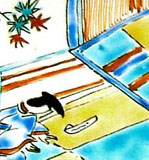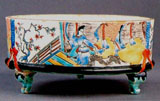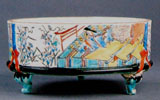- Museum Accession No.: EA1997.170
- Catalogue No.: 88
- Object type: Tripod vessel
- Kiln/Location: Kakiemon-related style, Arita
- Period/Date: late 17th century
- Dimensions: D. 15.0 cm
- Provenance: 1997.170
- Description: Porcelain tripod vessel, probably the lowest tier of a jubako. The cylindrical body raised on three bracket legs with relief moulding in the form of cords above. Inner rim unglazed. Kakiemon palette. The outside decorated area divided into three sections by the cord moulding. Each section contains an interior scene in an almost Yamato-e style. In one, a woman in a blue and red kimono sits on a terrace with blue flowers opposite. In another, a man in a blue and red kimono kneels on a terrace before his master inside, a maple tree in the background. In the last, a man in a blue and red kimono and carrying a piece of green and red fabric takes leave of a woman, partially concealed.
The subject matter is uncertain. Professor Miyeko Murase has suggested that the presence of the morning glory flowers beside the lady may refer to chapter 20, Asagao, of the Tale of Genji. Such scenes are extremely rare on Kakiemon and Kakiemon-related wares. This and its pair appear to be the only Kakiemon style jubako, or even parts of jubako, recorded. In all probability, there were two more tiers, and a lid, and the cord would have been arranged as a knot on the lid. The jubako shape is extremely rare in 17th-century export porcelain. An Imari jubako in the Hof-Tafel und Silber Kabinett, Vienna, is illustrated in Pantzer, 2000, no. 21. There is a imilar example in Dresden, inventoried in 1721, numbered N:26+. Formerly in the collection of the Duke of Northumberland, where it was one of a pair; similarly, only the base of the other survives, in a Japanese private collection.
- Exhibited:
- Similar Example:
- Illustrated:
|
Main View
|






